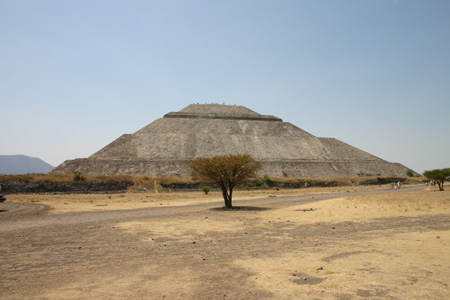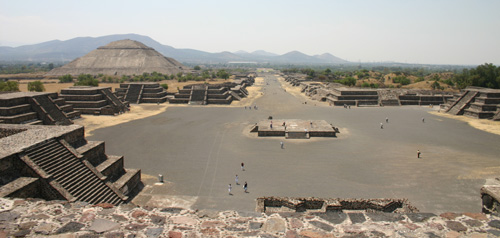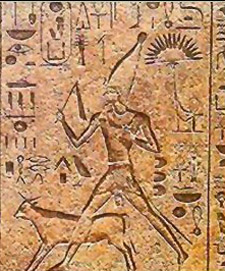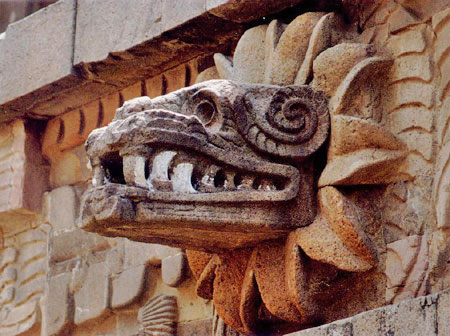|
New Fire Ceremony from Paranormal Magazine (UK) September 2007 from PhilipCoppens Website
Are pyramids just tombs?
Leading research, reported in my book
“The New Pyramid Age”, suggests the answer is no. Instead, they seem
to be the location where kings performed a ritual of rejuvenation,
linked with the cosmic cycles of time. Evidence of this ritual has
been independently found in Mexico and Egypt.
Father Bernardino de Sahugun’s Aztec informants stated that this ceremony occurred at the end of every 52 year Calendar Round.
The Aztecs and their predecessors had carefully observed the Pleiades and on the expected night the constellation was supposed to pass through the zenith, precisely at midnight, the New Fire ceremony was performed.
Now, only the sacred fire could be seen in the darkness, still quaking in the wind following the recent chaos.
Two deities, Nanahuatzin and
Tecciztecatl, both tried the divine sacrifice. One burnt quickly,
the other roasted slowly. Then Quetzalcoatl manifested himself and
was able to survive the fire, ensuring a new World Age – ours.
The text underlines the essence of the
Mayan’s religious experience, namely that life is a spiritual
journey to ascension – a return to God, the One who created the
universe. The text explains how the supreme deity, Tloque Nahauque,
manifested itself as three forces – a duality functioning against a
neutral background, from which the four prime elements (Water, Fire,
Earth, Air) were created.
The American author John Major Jenkins has described this as,
It is clear that Teotihuacan formed a site where this New Fire festival was performed: the cave inside the Pyramid of the Sun, with its specific alignment, is primary evidence.
But we also need to ask whether the pyramids of Teotihuacan were – could be – a visual representation of the hallucinogenic landscape that the initiates experienced; was Teotihuacan the materialistic representation of a dream?
The Mayans were interested in Orion, especially Orion’s Belt, and specifically the triangle of stars below Orion’s Belt (Al Nitak, Saiph and Rigel), which they identify as a hearth, with the Orion Nebula as the fire. And it is this hearth that they stated had been lit on August 12, 3114 BC – the day of creation – the date of the first New Fire ceremony of our World Age.
It is this calendar that is slowly running out of time – to end
on December 22, 2012 AD.
Intriguingly, the pharaoh accomplished this state in a place known as the “akhet”, often translated as “horizon”, but which should be interpreted as a place of spiritual illumination, which Mircea Eliade labeled “an awakening” as well as “ascension”. Egyptologist Mark Lehner has suggested that this akhet is the Gizeh plateau and hence we need to wonder whether this state of mind or consciousness was attained in Gizeh. We quickly add that part of the ceremony was performed in a “secret chamber”, which possessed a bed or a sarcophagus.
As it was here that the “state of akh” was accomplished, should such a chamber be located somewhere on the plateau too? If so, could it be the King’s Chamber in the Great Pyramid?
Jeremy Naydler has titled one of the chapters of his book “The pyramids as the locus of secret rites”.
He argues that the Heb Sed festivals were performed in pyramids. There is an obvious contradiction in the fact that the construction of a pyramid seemed to be abandoned as soon as a pharaoh died. When he was most in need of a tomb, all work on his tomb was stopped?
Let us note that several pharaohs who did not live long enough, had no pyramids whatsoever. Djedefra, Khufu’s son, did not live very long and his pyramid was never completed – though he clearly died, the son of a dynasty of pyramid builders extraordinaire who could surely have spared some men to build at least a small or minuscule tomb for this king? If the successor was in his early twenties when he ascended to the throne, there was more than enough time left before he had to wonder about his own death, as the life expectancy of an Egyptian pharaoh was not too different from most of us today.
But each time, work is stopped, as if the pyramid is no longer required now that the pharaoh is dead. In the “pyramid=tomb”-equation, that does not make sense.
According to Rainer Stadelman, two of the three pyramids of Sneferu were built between his 14th and 30th year of his reign. Coincidence, or evidence of a link with the Heb Sed festival? And whereas Sneferu had only one body and hence only the need for one pyramid, his exceptionally long rule, would have seen more than one Heb Sed festival.
Mystery solved?
To use Naydler’s own words:
Let us also add that the causeway of the Great Pyramid also has scenes of Khufu’s Heb Sed festival. There is also the famous Heb Sed dance, in which the king circumambulated the courtyard, which represented the country of Egypt. Such large courtyards stand in front of the Pyramid of Zoser, but are also present at the Gizeh pyramids of Khufu and his successor Khafre.
We can only wonder whether they are an Egyptian equivalent to the ball court of Chichen Itza or other squares, such as the Nunnery of Uxmal of the Mayan world.
Every 52 years, the Mayans practiced a New Fire ceremony, in which all the fires throughout the Mayan lands were put out for one night, before they were rekindled the next day.
To underline that this was a true cleansing of the past, even debts were erased. The ancient Egyptians had a similar “New Fire Ceremony”, which occurred at least every thirty years, in which the pharaoh underlined his ability to be able to unite the various dimensions and act as a mediator between these worlds.
Schele and Friedel noted how,
One of the most common rituals associated with the Vision serpent involved invoking ancestral sprits. Especially during coronation rites, the kings would contact the spirits for guidance and blessings. It was the Vision Serpent that provided the medium for contacting these deities.
Is it any coincidence that Lord Pakal’s sarcophagus lid has been described as,
...rather than the depiction of an ancient astronaut, as some interpretations propose?
Within these cosmic spirals of time, the Mayan kings acted as portals between different planes of reality. Through bloodletting, they conjured “the way” (the path) and the “ch’u”, the companion spirits and gods.
Likewise, the balance of the universal world order in Egypt was known as Ma’at, which was, if anything, a state of mind… a state of balance, in which life was good and society was in balance.
It was trying to bring Heaven down to
Earth and it was the task of the pharaoh to accomplish this… inside
the pyramid.
|



